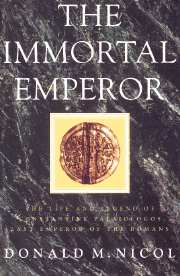Book contents
3 - CONSTANTINE: EMPEROR AT CONSTANTINOPLE
Published online by Cambridge University Press: 28 October 2009
Summary
The news of the Emperor's death came to Constantine at Mistra. He must have known that his brothers Thomas and Demetrios were nearer the scene and that either might forestall him by making a bid for the succession to the throne. Thomas reached Constantinople on 13 November; Demetrios hurried to the capital from Selymbria. Thomas was perhaps not a serious rival. Demetrios, however, had many supporters; for he represented, or claimed to represent, the interests of the powerful anti-unionist faction who looked for an Emperor who would wipe away the shame of the Union of Florence. They would have welcomed Demetrios as Emperor since it was his declared policy to disown the union of the churches which had caused so much bitterness and brought so little reward. It was the resolute action of the Emperor's mother Helena which averted a crisis and prevented the possibility of civil war. Helena, widow of Manuel II, asserted her right to act as regent until Constantine, the eldest of her surviving sons, reached Constantinople. He had always been her favourite and had always been proud to bear her Serbian family name of Dragaš or Dragases as well as his father's name of Palaiologos. Thomas readily accepted her decision and Demetrios was overruled. Both joined her in proclaiming Constantine as the new Emperor of the Romans. The first to be informed was the Ottoman Sultan Murad II; and in December the Empress sent Sphrantzes to secure his approval for the appointment of Constantine.
- Type
- Chapter
- Information
- The Immortal EmperorThe Life and Legend of Constantine Palaiologos, Last Emperor of the Romans, pp. 36 - 53Publisher: Cambridge University PressPrint publication year: 1992



